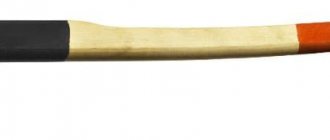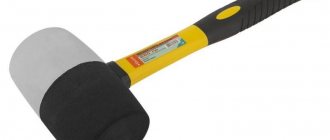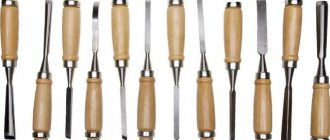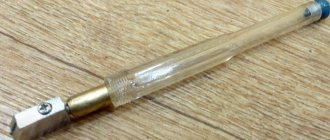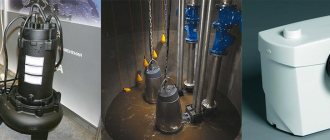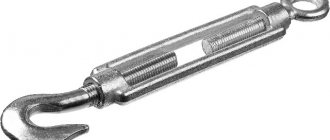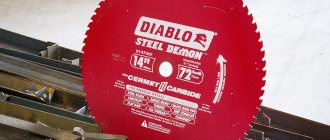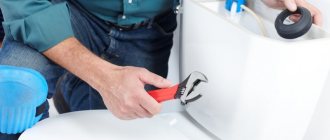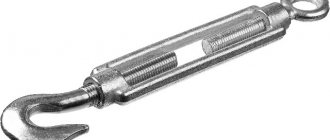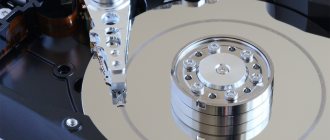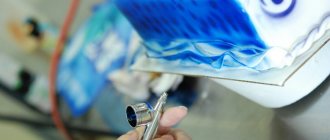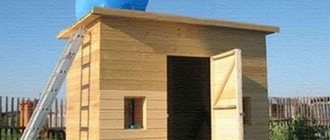A sharpening stone can be synthetic or natural, made of silicon, aluminum oxide, or diamond-coated. There are also water and oil stones for sharpening cutting surfaces.
The most popular manufacturers of whetstones are the USA, Russia, China and Japan. The standard surface grain parameters of a tool in the latter country are recognized throughout the world and are considered an accurate indicator of its effectiveness.
The price of sharpening stones varies - from 116 rubles to infinity. If we take the optimal price-quality ratio of the product, then its cost will be 3-6 thousand rubles.
Sharpening stone: what is it, what does a whetstone mean?
A sharpening stone is a tool that belongs to the category of universal ones and is used for the full maintenance of knives, razors, scissors and other objects with a cutting edge.
They are considered the optimal choice for sharpening because they allow you to independently choose the intensity of processing of the cutting edge and adjust the pressure force - this is the main difference between sharpening stones and machines with high speeds, work on which often leads to damage to cutting tools.
The whetstone can come in different sizes, the smallest are called whetstones.
| Materials for making whetstones | Natural, synthetic |
| Coating grain | Small, medium, large |
| Types of whetstones | Diamond, ceramic, water, abrasive, emery and others |
| Production | Japan, Russia, USA, China |
| Price | From 300 rubles and above |
Grinding stone grit: table
When choosing a sharpening stone, pay attention to its grain size - a parameter that indicates the level of aggressiveness of the impact on the sharpening surface; its characteristics and types are presented in the table.
Too large grains on the surface of the whetstone leave grooves/scratches on the cutting surface; this is unacceptable for some materials and tools. And professionals consider a sharpened surface to be ideal if it is free of burrs and any other defects. Therefore, the coarse grain size of the stone is suitable for rough repair and restoration work.
If you use a sharpening stone with a fine-grained surface, the quality of the work will be very high, but it will take a really long time to get the desired result. Experienced sharpeners recommend having sharpening stones with different grit levels available in order to start the process with rough sharpening and finish with bringing the cutting surface to “ideal”.
Stones from the Small NANIWA Flattening Stone series of various grain sizes
What is grit
Grit, grit is the level of grit of sharpening stones. This technical parameter is indicated in numbers, for example: if we are talking about a stone with a grain size of 120 grit, then it is used for rough sharpening of the cutting surface (coarse grain), finishing the sharpening work with fine grain stones (1200, 3000, 8000 grit).
What types of sharpening stones for knives are there?
Sharpening stones for knives are divided into two main types - natural and synthetic.
| Natural | Synthetic |
| Consist of minerals mined as minerals | Made from heavy-duty materials bonded together at high temperatures during processing |
| Two subspecies are considered popular - Arkansas and Japanese | There are 3 main subtypes - diamond, water and ceramic |
| There are 3 strength classes - soft, medium, hard | Features a long service life |
Water
Sharpening water stones (wet) belong to the category of artificial (synthetic), made from carbide and oxides of silicon, aluminum, and chromium. The production technology of this tool is such that the presence of particles of different sizes in the structure of the stone is not allowed - this negatively affects the results of sharpening cutting devices.
Depending on what binder material is used in production, water stone can have different hardness. For example, if the “bundle” is ceramic, then this indicator will be high, and if bakelite is used, it will be lower.
The peculiarity of a water (wet) whetstone is the need to soak it before starting work. Depending on the grit level of a particular instrument, soaking time can vary from 5 minutes (coarse grain) to 15 minutes (fine grain). You can tell that the tool is ready for use by looking at the air bubbles in the water - as soon as they stop forming, you can start sharpening the cutting surfaces.
Russian water stones Petrograd Water stones RUBANKOV.NET Sharpening water stones GRINDERMAN Chinese water stone
After soaking, the grinding surface is an accumulation of a mass of water, tiny metal particles and abrasive chips. This ensures uniform sharpening of the entire cutting surface.
Emery
Emery whetstones are used for electric machines that are equipped with grinding wheels (“emery pads”). At home, you should use white emery stones - they are durable, suitable for sharpening soft metals, and can be used for straightening knives and scissors. The composition of the material is soft, the temperature when the metal rubs against the stone is low, and the result is a fairly high-quality sharpening of tools.
There are also green sanding stones that are designed for working with hard metals. They have a high friction temperature, so they are not used for sharpening kitchen knives and scissors - scale will instantly appear on the blade, and the cutting surface will be hopelessly damaged.
Green grinding wheel White grinding wheel
Sandstone grits can be 8, 12, 16, 25 and 40, with 8 being the finest surface grit and 40 being the coarsest.
Diamond
Diamond is recognized as the hardest mineral in the world, it is used in the manufacture of sharpening tools with different grain sizes. The working layer of this mineral is made very thin, because the material is too expensive, but this does not affect the service life of the sharpening stones. It is believed that you can use such a sharpening tool for 10 years or more.
Diamond sharpening stones act very aggressively on the cutting surface and, although they allow you to complete the process in a few minutes, they quickly render it unusable and cause breakage of knives and scissors. Experts recommend that beginners limit themselves to medium-grained bars without such coating.
The difference between a diamond sharpening stone is that its surface is not clogged with foreign particles , so after use the tool is simply rinsed with cold water.
Watch the video about budget diamond sharpening stones:
A really high-quality stone of this type is quite expensive, but if you buy cheaper analogues, the surface will wear away very quickly. Accordingly, the service life will be reduced significantly.
Ceramic
The most modern type of abrasive stones is ceramic, in the production of which special materials are used (they are also used for the production of microcircuits). Ceramic can be used directly to make bars for sharpening cutting surfaces or an abrasive surface.
Sharpening tools on ceramics takes a long time and slowly; often such stones have a specific shape, which allows craftsmen to sharpen needles, nail scissors, fishing hooks, and blades. To begin work, ceramic stones are not wetted with water, but must be washed at the end of the process.
Ceramic stone (alumina ceramic) Fine Grit Tojiro F-472 – Ceramic water stone
Natural
The most popular are Arkansas and Japanese. Arkansas stones are a natural combination of quartz and rocks. The materials for its manufacture are mined in America, but their reserves are strictly limited, so the cost of such an instrument is always very high.
The second subtype of natural stone is Japanese waterstone. The material is mined in many regions of the country, but due to restrictions on its extraction, the cost of a sharpening tool will be “obscenely high.”
Professional natural stone Arkansas Translucent 1200 grit Japanese water stone S-3000/1000 on a stand
Oily
Oil sharpening stones are made from durable ceramics and have a longer service life because a more durable binder material is used in production. The peculiarity of oil whetstones is the variety of their shapes, which makes it possible to work with non-standard tools such as “bread” knives and serrated ones.
The surface of the stones has absolutely the same grain size, and this significantly speeds up work on them. There is also a drawback: it is impossible to achieve a “mirror” surface of the blade; it is better to use them at the “grinding” stage, when you need to make the blade thinner or remove small defects from its surface.
Watch the video review of Washita natural oil stone:
Round
Round sharpening stones are used for working on machine tools. They can be made from different materials, but more often they are synthetic - the machine produces too high speeds, so the hardness of the device must be maximum so that the blade or the stone itself does not collapse during operation.
The slipper type of tool is also available in small sizes; it is a cylinder that can be used to sharpen any knives. Manufacturers warn that it is impossible to achieve a perfect result with such stones, but they are effective as a “correction”.
Round whetstone
How to sharpen knives using Japanese water stones?
Water sharpening stones differ from others in that before use they must be soaked in water for some time (from five to twenty minutes, depending on the hardness of the stone). Why is this being done? When working with dry stone, its pores quickly become clogged with waste metal, or rather, metal powder. As a result, the surface of the stone becomes smooth and loses its abrasive properties. On the surface of a wet stone, during the sharpening process, a kind of suspension of stone chips and metal powder is formed. Under no circumstances should it be washed, since it is precisely this that ensures the high quality of sharpening the blade. All over the world, Japanese water stones are especially popular among specialists. Suehiro, King and Naniwa brands guarantee the perfect sharpening quality of your knives. The technology for making and using such stones has been honed in Japan for centuries and improved by many generations of sword and knife makers. As you know, Japanese knives differ from European ones not only in the form of sharpening, but also in the traditional use of very hard steel grades. A hardness of 60–61 HRC for a Japanese knife is considered ordinary, while European blades rarely have values higher than 57–58 HRC. Sharpening hard steel requires very high quality, fine-grained sharpening stones. Initially, the Japanese used natural raw materials, but with the development of technology, very high-quality artificial stones appeared on the market, much superior to natural ones in uniformity (and this is very important for good sharpening) and in the breadth of the grain spectrum. So, let's start the sharpening process. As already mentioned, the stone must first be soaked in water. A fairly deep plastic container is suitable for this, and it is advisable that you have a separate container for each type of stone. In this case, large abrasive particles will not be able to accidentally fall on the surface of fine-grained stones. Coarse-grained stones are soaked for an average of five minutes, fine-grained stones - up to twenty minutes. The stone should be removed from the water when air bubbles stop escaping from it. The next stage is fixing the stone. This is necessary to free up your hands - it is impossible to sharpen a knife on a stone with one hand. There are a great variety of different mounts for sharpening stones - from specialized ones that are sold in stores, to ordinary bench vices with pads and homemade devices. If you are going to use a dense stone with a high grain size, then you must first artificially create the already mentioned suspension on its surface. This is done using a special bar. If your knife is in poor condition - it is very dull or its cutting edge is damaged, then you need to start sharpening with a coarse-grained stone (up to 400 units). It is necessary to put the slopes of the knife in order, for which you will have to work on individual parts of the blade. Depending on the length of the blade, mentally divide it into several parts (from two to five), starting from the heel and ending with the tip. Treat each of these sections, starting from the tip, separately, with the axis of the knife forming an angle of approximately forty-five degrees with the longitudinal axis of the stone. To sharpen the very tip of the knife, press it against the stone with the pad of your thumb. It is very important not to change the factory sharpening angle of the knife. Depending on the purpose, type and country of origin of the instrument, this angle can vary from 15 to 40 degrees. When sharpening, try to lay the trigger of the knife flat on the stone. To facilitate the process, there are special clips that are attached to the blade of the knife and are designed for different sharpening angles. When sharpening, the knife blade moves towards its spine, and a burr forms on the opposite side of the blade. If it has reached an equal thickness throughout the treated area, it is time to move on to sharpening the next section of the blade, gradually moving towards the butt of the knife. The second stage of sharpening is processing the blade with a stone with a grain size of 700 to 2000 units. If your knife was not severely damaged or dull, then this stage may well not be the second, but the first and main one. When working with medium-grained sharpening stones, the sharpness of the cutting edge is restored and traces of rough processing are removed. The working technique is similar to the first stage already described, but the burr formed on the blade will be much smaller, and the process of grinding off the metal is much slower. The next stage is finishing. Fine-grained stones are used here - from three to five thousand units. We use the same technique of gradual advancement through sections, but at this stage the burr is no longer formed, and therefore the result of the work must be assessed visually. To do this, you need to look at the tip, holding it in the “towards you” position. If a section of the blade is not sharpened enough, it gives off a glare; a perfectly sharp blade is almost invisible. Experienced craftsmen check the final sharpness of the blade by running the knife blade along the hairs on the hand - a well-sharpened knife cuts them like a razor. For those who strive for complete perfection, there is a fourth stage of sharpening, which would be more correctly called polishing. This is the processing of a knife blade with stones with a grain size of more than five thousand units (note that there are sharpening stones reaching 20,000 units). This stage is necessary more for professionals than for people sharpening their home kitchen knives. Only high-class specialists can work correctly with such stones, but it is very easy to ruin the cutting edge by clumsy polishing. It is not for nothing that good blade polishers in Japan are very highly paid specialists. Finally, some useful tips. When sharpening a knife, increase the pressure gradually, moving from light touches to more intense work. The suspension that forms on the stone cannot be washed off; you just need to make sure that it does not become too thick. To maintain the required consistency of the suspension, many craftsmen from time to time simply dip their fingertips into water and shake off the drops onto the stone. You can also use a spray bottle. When working, try to use all areas of the stone so that its wear is more even. If irregularities form on the stone over time, it must be treated with a special bar with a relief surface. If the sharpening stone has become very thin, it can be glued to a plate of wood or plexiglass. Store your bars in a special container. If you use them frequently, it is best to store the stones in water. In this case, the water must be changed regularly and the container must be closed with a lid. If the bars are rarely used, you can dry them after use.
Stones for sharpening knives: the best by manufacturer
The best manufacturers of stones for sharpening knives are considered to be Russia, Japan, China and the USA; Soviet-made tools can still be found on sale, and many professionals prefer them.
Russian made: Petrograd, Grinderman, Gritalon
Sharpening stones, which are produced in Russia, are distinguished by the correct price-quality ratio.
Of the most popular, it is worth highlighting:
| Name | Description | Photo |
| "Petrograd" | This brand produces silicon carbide stones that are distinguished by a variety of surface hardness. It is important that the degree of graining exactly corresponds to Japanese standards - they are recognized throughout the world as the best. | |
| "Grinderman" | The production is located in St. Petersburg, the company not only produces various sharpening tools, but also provides full service. | |
| "Gritalon" | They produce synthetic abrasive tools that can be used both for sharpening machines and for manual work. The material used in production is silicon carbide. |
Japanese: Suehiro, YOSHIKIN, Yaxell, Samura
Sharpening stones made in Japan are usually used for manual work and with water; the most famous brands of such tools are:
- Suehiro;
- Yoshikin;
- Yaxell;
- Samura
The difference between such stones is that when sharpening cutting surfaces, new layers of abrasive are constantly “opened”, and particles of the previous ones are mixed with water and have the best possible effect on the blade.
Sharpening stone Samura Sharpening stone Yaxell Sharpening stone Global MinoSharp from the manufacturer Yoshikin Sharpening water stone Suehiro
The Japanese produce sharpening stones with different degrees of grain, so when using a tool with fine grains at the last stage, it makes it possible to bring the cutting surface to perfect condition without the additional use of pastes, felt and dressing slings.
Japanese water stones are distinguished by the highest productivity, which can only be compared with diamond tools. But the latter increases the risk of excessive thinning of the blade at the final stage of finishing the cutting surface.
Japanese whetstone grit standards are recognized by international organizations and are used for designation by most manufacturers.
Soviet
Soviet sharpening stones are bars of absolutely regular shape, onto which a coating of abrasive material (base – silicon) was applied. You can still find Soviet sharpening stones and whetstones on sale at flea markets - they are considered high quality and “eternal.”
On the territory of the USSR, they used their own, individual markings, which are radically different from modern ones.
What was indicated on each product:
- dimensions;
- accuracy class;
- manufacturer (each had its own mark);
- dimensions;
- hardness level;
- structure characteristics;
- product type;
- material used in manufacturing;
- grain level.
Microcorundum block for straightening USSR razors, 1970
Chinese: Ganzo
Chinese sharpening tools include silicon carbide and aluminum oxide stones, which are characterized by fairly high quality, long service life and low cost. The most famous manufacturer is Ganzo. Such tools are especially good for sharpening ordinary kitchen knives - their grit level does not exceed 1000 grit, which allows you to bring the blade to the desired sharpness with one whetstone.
Recently, sharpening stones from China made of vacuum ceramics and boron carbide have appeared on the market. They have an almost eternal service life; even with prolonged sharpening of the tool, they do not wear out.
Chinese sharpening tool Ganzo
Arkansas: Dan's, Smith's, Lansky
Three companies stand out from the manufacturers:
- Dan's;
- Smith's;
- Lansky
Arkansas is a state in America where abrasive material is mined and grindstones are produced. Mineral reserves in this part of the country are already greatly depleted, so the cost of the tool is very high even by the standards of the Americans themselves. However, Arkansas stones have always been popular and are now considered the best quality on the market.
Lansky whetstone Smith's whetstone Dan's whetstone
About water stones (sharpening stones). Sharpening knives with your own hands.
Water stones are special, highly effective sharpening stones that have different grain sizes, which allows you to change them during the sharpening process from coarse-grained to fine-grained to achieve perfect knife sharpening. These stones cannot be worked on dry; before sharpening they must be soaked in water, which is why they are called water stones.
ADVANTAGES AND DISADVANTAGES OF WATER STONES
ADVANTAGES
- Uniformity of abrasive grains in the composition of the bar.
- Softness, which is determined by the ratio of the pore volume to the volume of the bond and the abrasive grains themselves. Because of their softness, the bars grind off faster, constantly exposing new abrasive grains, while the already worn grains form a suspension along with water on the surface of the bar. Therefore, water stones at higher wear rates provide consistently high performance with good surface finish.
- Fine-grained bars provide a fairly quick finishing of the cutting edge to almost perfect condition without polishing pastes, felt wheels and other accessories.
- Water stones have a significantly higher productivity, which is second only to the material removal rate of diamond. However, diamond stones have a more limited grit range (typically up to 1200), and in the final stages of diamond sharpening there is a significant risk of overdoing it and thinning the blade too much.
DISADVANTAGES
- During operation, lubrication is required, and regular flushing of metal dust and erased abrasive is also necessary. In addition, natural stones wear down quite quickly, and not always evenly, which leads to the need from time to time to level the surface of such a block to a plane. For this operation you will need a fairly massive glass or marble plate with a good plane, water, and a lot of large waterproof sandpaper. The sandpaper is applied to the plate, and with light movements of the sharpening stone on the sandpaper moistened with water (or better under running water), changing the sandpaper as it wears out, the working plane of the stone is restored to its original appearance. This operation is only required for natural stones. Severely worn, thinned natural stone can be glued with durable glue onto a block of hard wood, such as beech, to prolong its use to the maximum.
- Price. The cost of water stones is significantly higher than conventional abrasive stones.
PROCEDURE FOR WORKING ON WATER STONES
You cannot work on such stones dry. They should not just be sprinkled with water, but thoroughly wetted. The “soaking” time is determined by the air bubbles released by the bar. Large porous stones will bubble as they absorb water for about 5 minutes. Smaller and medium grain sizes are saturated in 10-15 minutes. The densest, fine-grained bars are “soaked” for 15-20 minutes.
The stone is then placed on the holder. There are a great variety of them - from store-bought to homemade. The requirement for the holders is to ensure a stable position of the abrasive and prevent it from moving during operation, since you will need both hands when sharpening. On fine-grained stones, before editing, it is necessary to create a layer of suspension, for which a block of fine-grained limestone is used. Now the stone is ready for use.
During grinding and polishing, the amount of suspension will increase. It turns out to be quite dirty work. There is no need to rinse it off, just make sure that it does not thicken too much, periodically moistening it, dipping your fingertips into water and shaking water off them onto the block. You can use a household spray bottle or a disposable syringe - just try not to accidentally wash it off completely. Try to use the entire area of the block. During intensive metal removal when working with coarse-grained abrasive, monitor its wear. As a rule, the middle part of the bar wears out as much as possible, which distorts the working plane and “collapses” the cutting edge. There are quite a lot of means to combat this phenomenon. For these purposes, you can also use coarse-grained waterproof sandpaper glued to the glass. The block is placed on it with the worn side and moves in a circular motion, reminiscent of the number “8”, until the flat state is restored. You can use another, coarser-grained stone. It is important that the restoration is carried out with water, after which the abrasive is thoroughly washed with a brush to remove stuck particles of larger abrasive.
The bars should be stored in individual containers - plastic or cardboard. Coarse-grained and medium-grained (up to 1000 grit) - in water, especially if they are used regularly (once a week or more often). Usually they are stored in a container closed with a lid, and disinfectants are added to regularly changed water to prevent putrefactive processes. Rarely used bars are best dried after use. Fine-grained ones, on the contrary, are thoroughly dried after each use. You cannot leave a wet block in the cold - frozen water can destroy it. Regular dressing of the stone will help reduce uneven wear and make it easier to maintain. At the same time, to prevent chipping of the edges of the stone during work, it is worth periodically, as wear occurs, to create a narrow chamfer on its edges at an angle of 45 degrees. It is recommended to glue the thinned bar with waterproof glue onto a flat piece of thick organic glass or wood - this will extend its life.
SHARPENING KNIVES ON WATER STONES
No matter how good and well-made a chef’s knife is, sooner or later, due to high loads, abrasive wear and electrochemical effects, the geometry of its blade is distorted and the knife stops cutting. The purpose of sharpening is to restore the original profile of the cutting edge.
Cases of sharpening can be reduced to three main types:
1. Slightly dull blade. Bringing it to its original state is more correctly called editing: an unevenly deformed blade is leveled with an abrasive tool, for example, a musat; 2. Worn or severely dull. A badly worn blade requires more work. To do this, you will have to remove “extra” material from the sides of the cutting edge. This is done with fine-grained abrasive tools; 3. Very heavy wear. Significant damage to the blade - nicks, chips, etc. In fact, during sharpening, you will have to remove the bevels and shape the cutting edge - that is, not only sharpen the knife, but also repair it.
The marking of water stones is based on their grain size, the higher the number, the finer the grain size.
The number of stones in the set and their grain size will be determined by the task facing the sharpener. For finishing and editing, you can limit yourself to fine-grained stones 6000 and above. If the knife requires light sharpening, then it will first have to be sharpened on a whetstone with a grit of 3000 to 5000. Conventional sharpening is done with stones in the range from 600 to 2000.
If severe wear, nicks and other damage are noticeable on the blade, then they will first have to be removed with the coarsest-grained stones - from 80 to 400.
Sequential work on a very dull or badly damaged blade will look like this, for example: 220 – 700 – 1200 – 3000 – 4000 – 8000.
After soaking in water, place the stone on the holder. Suppose we received a damaged or very dull knife. Let's start with a coarse-grained abrasive from 80 to 400. At the first stage, we have to remove the nicks, for which we will mercilessly say goodbye to the remnants of the blade. In order not to distort the geometry of the blade, we remove the material along the entire length of the blade until the damage is completely eliminated. Now we have a straight edge in place of the blade. Immediately evaluate the uniformity of its thickness. If the thickness “floats”, then you will have to restore the profile of the knife, for which you will have to work with its slopes. Remove material where excess material is found. Upon completion of this work, the width of the edge at the blade site should be constant along the entire length of the blade. The thickness should be selected according to the purpose of the knife - taking into account further thickening by 20% - 30% when removing the cutting edge. Now you can carry out preliminary sharpening: it will clearly show those places on the slopes that still need to be corrected. Depending on the size of the bar, as well as the length and shape of the blade, divide it into approximately 2 - 5 parts along the length. You will have to work on each of them separately at the initial stages of sharpening. Metal removal should be done by holding the knife at approximately 45 degrees to the longitudinal axis of the block.
Supporting the blade on the side opposite the block, with the fingers of your other hand, begin working on the part of the blade near the tip, smoothly moving towards the end of the intended area towards the handle. The tip itself is turned by pressing the thumb against the blade near the tip. The knife should not change the “angle of attack” - if the profile allows, it is even better to lay it flat on the trigger. Sharpening is carried out by moving the knife towards the butt. At the same time, monitor the formation of the burr on the side opposite to the one being sharpened: when it is uniformly formed along the entire length of the area being sharpened, move to the next part of the blade, moving the knife on the block closer to the handle. Pay attention to the position of the fingers - to prevent the knife from wobbling, the fingers are located as close as possible to the area of the blade being sharpened. Having achieved an even burr along the entire length of the blade on one side, move to the other side of the blade and in the same way, from the tip to the handle, achieve an even burr on the opposite side. Turn the knife over again and carefully remove the burr, while simultaneously grooming the cutting edge along its entire length, after which you do the same on the opposite side. The bulk of the work on removing the material is now complete. Working with a medium-grain abrasive (from 700 to 2000), a similar technique, is used to remove traces of rough sharpening or restore the sharpness of a slightly dull blade. If there are no small nicks or teeth on the cutting edge, then you can start sharpening even with a 1200-grit stone. On these stones, the rate of material removal is much lower, and the surface cleanliness is higher. It is this range of abrasive stones that is used for the main sharpening work. The burr formed is much smaller. Following sharpening, the transition to abrasive with a grain size of 3000 - 5000 is associated with finishing. In general, already on the 3000 bar you can get a result that will immensely satisfy 99% of users. Finishing is carried out according to the same method, but the burr is no longer formed and the time of transition from one side of the blade to the other is assessed visually, holding the knife with the blade towards you: - insufficiently sharp areas glare, and the sharply sharpened blade is not visible. You can cut newspaper by weight or run it like a comb through the hair on the back of your head. A blade that is sharp will catch on your hair, and a blade that is not sharp enough will slip. The last step, the practical value of which is sometimes questioned, is straightening on whetstones with a grain size of 5000 to 8000 or more. During editing, the material is no longer removed, but the blade is simply polished, which improves not only the cleanliness of the surface, but also strengthens it. Editing requires several precise and precise movements on each side of the blade. It should be pointed out that working with stones with a grain size over 4000 requires very high individual skills, hand sensitivity and even a certain intuition; – what and how to polish, and when to stop.
ABOUT SHARPENING TECHNIQUES. GENERAL PRINCIPLES.
Sharpening (grinding) at high speed, for example on a high-speed grinding wheel, causes strong heating of the material being processed, which is fraught with uncontrolled and undesirable spontaneous tempering of the hardened blade, or at least part of the cutting edge of the blade. A thin strip of steel heats up instantly; periodically dipping the blade being processed into water cannot prevent this. Therefore, never sharpen knives on a high-speed grinding wheel; most likely, you will ruin the knife forever!
The main thing when sharpening is to set a constant angle. Force is not needed here at all and all attention should be focused on ensuring that the abrasive tool meets the blade at a constant angle. This is the essence of all sharpening techniques, regardless of whether you move the blade along a fixed sharpening tool, the tool along a fixed blade, or you work with a blade and an abrasive tool in opposite directions, holding the knife in one hand and the sharpening stone with the other. There are two ways to maintain a constant angle. The first is to purchase special devices that make it easier to set a constant sharpening angle. The difficulty of setting a constant angle when sharpening on a flat abrasive (bar) lies in the rather inconvenient and unusual position of the hand for a novice sharpener: you seem to be trying to cut off the top layer of a fraction of a millimeter from an abrasive tool with a knife. Moreover, alternately with one or the other side of the cutting edge. Devices help simplify the task: the sharpening bars are either arranged in a V shape in such a way that the user makes simpler and more familiar movements - pulling the knife towards himself from top to bottom, or due to the forced setting of the direction of movement by the guides, the hand has a limited degree of freedom and therefore wobbles less. Begin sharpening the blade with a rough whetstone so that a burr appears along the entire length of the blade, and when sharpening the blade on both sides, it bends back and forth, but does not break off. After a burr appears, they switch to a block with a finer grain. A sign that it’s time to change this block too - complete removal of sharpening marks from the previous block. And to make it easier to distinguish marks from different whetstones, it is better to sharpen in different directions, that is, when working, one whetstone is held at an angle of 45° to the longitudinal axis of the knife, and when switching to a smaller whetstone, the latter is turned 90°. Do not pay attention to the burr and don't try to tear it off. Word, they simply sharpen the chamfers, changing the bars (from coarse-grained to fine-grained). And when they come to the bar with the finest grain, they begin to remove the burr. It is ground off on both sides of the blade with the finest grained stone so that the cutting edge of the blade acquires an angle of 23 - 45°.
We hope that this article will help you decide on the method of sharpening knives and choosing the necessary tool for this purpose.
Sharpening stones for machine tools
Sharpening stones for machine tools vary in shape and composition. They can be used for sharpening not only cutting tools, but also any other metal products. Most often you can find a stone made of silicon carbide, but the most durable is considered to be CBN - an abrasive material based on boron nitride, which makes the tool as durable as possible.
All sharpening stone attachments for machines are divided into two types: black – the most resistant/strong and green. The first is used for rough sharpening of the cutting surface, while green is used to bring it to the desired state.
Sharpening machine 150 mm Titan BNS25-150
Which sharpening stone to choose for kitchen knives
For kitchen knives, it is better to choose a water sharpening stone - they “work” faster and allow you to straighten the cutting surface without changing tools until you get the desired result. But you need to remember that some knife materials can rust when in contact with water, which will hopelessly ruin your kitchen tool. In this case, it is better to use oil sharpening stones - sharpening takes a long time, but it is always of high quality, and the blade of the knives does not rust.
As for the grit level of the whetstone, 1500 grit is sufficient for kitchen knives, because 240 grit is too coarse an abrasive surface that greatly thins the knife blade.
Advantages and disadvantages
Opinions on the feasibility and productivity of these stones are very ambiguous, but the following main pros and cons can be identified.
pros
- all grains included in the bar are as homogeneous as possible;
- Due to the softness of its surface, that is, the optimal ratio of pore volume, binder and abrasive, the bar grinds down somewhat faster, constantly opening up new grains. At the same time, a certain special suspension forms on the block in a pile of water. Due to this, Japanese water stones, with faster wear, guarantee the same high efficiency and high-quality clean surface treatment;
- with the use of small-grained stones, it is quite simple and quick to achieve an almost ideal cutting edge without the use of any polishing compounds or similar accessories;
- Water stones for sharpening knives have high productivity and are inferior in this factor only to diamond-coated materials. But it is worth considering that diamond bars have a limited grain size (up to 1200 units).
Minuses
- during the sharpening process it is impossible to do without lubrication and constant washing away of dust from metal particles and abrasive abrasive;
- natural stones wear down quickly, unevenly, which requires leveling the surface;
- the price is an order of magnitude higher than the cost of simple abrasive bars.
Japanese sharpening stones of various types.
How to choose a sharpening stone for tools
The selection of a whetstone should be made taking into account the following parameters:
- Abrasive grain size . It can be small, medium and large. The latter is necessary to eliminate chips on the surface of the cutting tool, because only coarse grain size can remove layers of damaged metal.
- Material of manufacture . In terms of characteristics and service life, synthetic sharpening stones are many times superior to natural ones, but this ratio is appropriate to take into account only when choosing a device from the middle price category. If you are planning to purchase a high-quality sharpening stone, then you should pay attention to Japanese manufacturers.
- Dimensions . If a stone is purchased for sharpening kitchen knives, then the shape and size practically do not matter. But if you constantly use a sharpening device on hikes, at work you should choose small sizes, even pocket-sized options.
What grit to choose for sharpening a knife
The grain size for sharpening a knife should be selected depending on the goals pursued; experts say that you need to have at least 3 stones in your arsenal:
- 120 grit – for rough metal processing;
- 1000 grit – to level the surface;
- 2000 grit – for straightening the blade.
But practitioners believe that knives can be sharpened with a stone with a grain size of 1500 grit. Such kitchen tools come straight from the store sharpened and only need to be slightly adjusted during use.
Main criteria when choosing a stone
Before purchasing a tool you must:
- Select abrasive material. In everyday life, ceramic products are more often used, for example, a boat-shaped block. A double-sided sharpener with a rough and smooth surface is often found. Diamond stones are rarely used in professional sharpening of kitchen knives. The high price limits the spread of natural abrasives.
- Pay attention to graininess. When sharpening, use bars with a grain size of 600-800 units. To polish the edge, bars marked 1500-2000 are used. Bars with a grain size of more than 2000 are intended for professional work.
- Consider the scope of use. The size of the block should exceed the length of the blade by 1.5-2 times.
How to make a whetstone with your own hands
You can make your own whetstone from ceramic tiles or silicon carbide and epoxy glue, but first you need to prepare a template and then follow the instructions.
From ceramic tiles
You need to take a fragment of ceramic tile measuring 30x8 cm; if there are mortar residues on the back side, then they must be removed. The relief side of the ceramic tile is ground down on a grinding wheel or sand-lime brick by active friction. During this process, fine abrasive dust will be formed - it must be removed periodically. You can bring the surface completely smooth with regular sandpaper.
As soon as the back side of the ceramic tile becomes smooth, the remaining abrasive particles are removed/washed off and completely dried. The whetstone is ready, you can use it to sharpen your kitchen knives, but you will definitely have to sharpen them until they are impeccably sharp and smooth.
Watch the video on how to make a whetstone for finishing a knife from ceramic tiles:
Made of silicon carbide powder and epoxy glue
You need to purchase 100 g of silicon carbide powder, prepare a wooden board with cuts on one side to fix the abrasive bar, and epoxy glue. For ease of work, you should wear medical gloves and use syringes.
Execution order:
- Mix 6 cubes of resin and 1.2 ml of glue (epoxy glue preparation kit) in a bowl.
- Mix thoroughly and add a little abrasive powder.
- Stir again and add silicon carbide powder again - this must be done until the dry material runs out.
Next, you need to prepare a cardboard box of the desired shape (a rectangular or square block is needed) and pour the prepared adhesive mixture into it. Cover the top with a board, sawn side down, and press down with a weight.
Cardboard boxes of the desired shape
After 3-4 days, the glue will completely harden - and the block is ready for use. You will need to clean its edges and trim it with a file. To make the surface abrasive, you need to drop water on it and rub the frozen surface with a piece of glass with a small amount of sand.
Homemade sharpening stone for knives is ready
Such homemade sharpening stones do not have a long service life, but can be useful in force majeure circumstances.
Stone for dressing water stones
When using water stones, irregularities form on their surface, which impairs the quality of sharpening knives and other cutting tools; you can correct them:
- sandpaper;
- silicon carbide powder;
- sand;
- diamond block.
But it is easier and faster to sharpen the sharpening tool with special stones - synthetic water stones with diagonal cuts along the surface of the same depth. They can be hand-held or tabletop. In the first case, straightening is carried out with a stone with cuts, in the second, the damaged whetstone is ground/straightened on a fixed one.
The most popular stones for dressing water stones:
| Name | Description | Photo |
| Table stone from the Large series NANIWA Flattening Stone for Sharpening Stones (Truing Stone) | It has the same grain size (24 grit) and is made of silicon carbide. | |
| Table stones from the JUUMA Flattening Stones series | Made from aluminum oxide, they are a series of four stones of different grain sizes. It is noteworthy that they are able to rule even each other. | |
| Suehiro Hand Stones | They have a medium grain size (200 grit), are intended for straightening synthetic water stones, correcting both subtle unevenness and deep “pits” and grooves. |
Sharpening household tools
Having chosen a stone for sharpening knives, you need to learn how to set the sharpening angle of the blade, familiarize yourself with the procedure step by step, and the features of the technological process.
Angle Definition
Choosing a whetstone for sharpening knives is not as difficult as setting the required angle. It is chosen depending on the purpose for which the cutting edge will be used. Classic sharpening angles:
- Razors, surgical instruments, blades - up to 10 degrees.
- Fillet knives for cutting vegetables -10–20 degrees.
- Professional chef's knives - 20–25 degrees.
- Universal tools - 25-35 degrees.
- Blades for hunting, heavy work - 30–40 degrees.
Do not forget to lubricate the sharpening stone with oil or moisten it with water. Tables of exact turning angles can be found on the Internet.
Types of thin sections
Sharpening stones can be double-sided or single-sided. The second option is more convenient. It is advisable to use several devices according to the grain size, so that it is possible to correct both gross and minor damage to the blades.
Stones of different grain sizes
Step by step procedure
To get a good effect, you need to do the work correctly. Step-by-step instruction:
- Diamond stones for sharpening knives must be prepared before sharpening. Check the abrasive surface for unevenness. It should be smooth.
- Place the stone so that the sanding side faces up.
- Take the knife blade with the cutting edge facing away from you. Perform straight movements. Moisten the stone with water when carrying out work.
It is forbidden to make movements in a circle or move the blade longitudinally. This can damage the cutting edge.
Knives are used in any kitchen; they are used by hunters, fishermen and travelers. To keep this versatile tool in working condition, you need to sharpen the cutting edge. To do this, you need to choose a block of abrasive material.
Stones for knife
Ceramic and diamond stones are used for knife blades in the kitchen. They are characterized by fine grain and therefore cannot sharpen the cutting surface efficiently - usually such kitchen devices are used for quickly straightening the blade.
The service life of such blades is short, the abrasive coating on them is thin. Some manufacturers produce a device with three stones - coarse, medium and fine, which makes it possible to increase the level of sharpening of kitchen knives.
How much does a whetstone cost?
A whetstone can cost 116 rubles or several thousand - it all depends on several parameters:
- material of manufacture;
- manufacturer;
- surface graininess.
The average price of a whetstone, where the price/quality ratio can be called optimal, is 3-6 thousand rubles.
